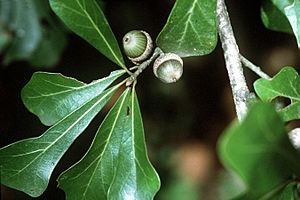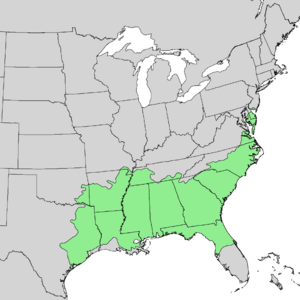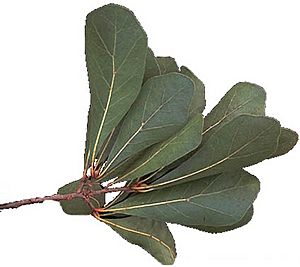Water oak facts for kids
Quick facts for kids Water oak |
|
|---|---|
 |
|
| Leaves and acorns | |
| Conservation status | |
| Scientific classification | |
| Genus: |
Quercus
|
| Species: |
nigra
|
 |
|
| Natural range | |
| Synonyms | |
|
List
Quercus agnostifolia K.Koch
Quercus aquatica (Lam.) Walter Quercus bumelifolia Riddell Quercus dentata Bartram Quercus genabii K.Koch Quercus marylandica Du Roi Quercus microcarya Small Quercus nana Willd. Quercus noviorleani Petz. & G.Kirchn. Quercus quinqueloba Engelm. Quercus uliginosa Wangenh. |
|
The water oak, scientifically called Quercus nigra, is a common oak tree. It is part of the red oak group. This tree grows naturally in the eastern and south-central United States. You can find it in coastal states from New Jersey to Texas. It also grows inland in places like Oklahoma, Kentucky, and southern Missouri. Water oaks like low-lying areas and can grow up to 450 meters (1500 feet) high.
Contents
What Does a Water Oak Look Like?
The water oak is a medium-sized deciduous tree. This means it loses its leaves every year. It can grow as tall as 30 meters (100 feet). Its trunk can be up to 1 meter (3 feet) wide.
Young water oaks have smooth, brown bark. As the tree gets older, the bark turns gray-black. It also gets rough, scaly ridges.
Leaves and Acorns
The leaves of the water oak grow one after another along the branch. They are simple, meaning they are not divided into smaller leaflets. These leaves stay on the tree until mid-winter. They are 3–12 cm (1–5 inches) long and 2–6 cm (1/2–2 inches) wide.
The shape of the leaves can vary a lot. Most often, they look like a spatula. They are wide and rounded at the top, but narrow at the base. The edges of the leaves are usually smooth or have shallow lobes. Each leaf tip has a small bristle.
It's easy to spot a water oak by its leaves. They often have a lobe that looks like a water drop hanging from the end. The top of each leaf is a dull green or bluish-green. The bottom is a lighter bluish-green. You might see rusty-colored hairs along the veins on the underside of the leaves.
The acorns grow alone or in pairs. They are about 10–14 mm (1/3–1/2 inch) long and wide. They have a shallow cup that holds them. Acorns take about 18 months to grow after the tree is pollinated. They are ready in the fall of the second year.
Where Do Water Oaks Grow? (Ecology)
Water oaks play a similar role in nature as other trees that like wet places, like the weeping willow. They are good at living in wet, swampy areas. You can find them along ponds and stream banks. But they can also grow in drier spots and even in hard, packed soils.
These trees grow in sandy soils, red clays, and old fields. They can be found near swamps, streams, and in low-lying bottomland areas. Water oaks grow and reproduce quickly. Because of this, they are often the most common tree in a group of trees.
Lifespan and Growth
Compared to other oak trees, the water oak does not live very long. It usually lives only 60 to 80 years. It doesn't do well when other trees block its sunlight. It needs a lot of light to grow.
Water oaks are often used to bring back hardwood forests in bottomland areas. These are places that were once cleared for farming or for growing pine trees. A water oak can start making flowers and acorns when it is about 20 years old. It produces many acorns almost every year.
Water oaks are not usually planted in gardens or yards. This is because they don't live very long. They can also get diseases easily and are very messy.
Water Oak Hybrids
Sometimes, water oaks can mix with other types of oaks to create new kinds of trees called hybrids. This can happen with trees like the southern red oak (Quercus falcata), bluejack oak (Quercus incana), turkey oak (Quercus laevis), blackjack oak (Quercus marilandica), willow oak (Quercus phellos), Shumard oak (Quercus shumardii), and black oak (Quercus velutina).
Animals and Water Oaks
The acorns from water oaks are a very important food source for many animals. These include white-tailed deer, eastern gray squirrel, raccoon, wild turkey, mallard ducks, wood ducks, and bobwhite quail. In the winter, deer also eat the buds and young twigs of the water oak.
Uses and History of the Water Oak
People in the southern states have used water oak wood since the 1600s. They used it for timber (wood for building) and for fuel. The wood is often sold as "red oak" along with wood from other red oak trees.
The water oak has other names too. Some people call it spotted oak, duck oak, punk oak, orange oak, or possum oak.
See also
 In Spanish: Quercus nigra para niños
In Spanish: Quercus nigra para niños



